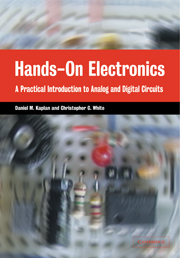Book contents
- Frontmatter
- Contents
- List of figures
- List of tables
- About the authors
- To the Reader
- Acknowledgments
- Introduction
- 1 Equipment familiarization: multimeter, breadboard, and oscilloscope
- 2 RC circuits
- 3 Diodes
- 4 Bipolar transistors
- 5 Transistors II: FETs
- 6 Transistors III: differential amplifier
- 7 Introduction to operational amplifiers
- 8 More op amp applications
- 9 Comparators and oscillators
- 10 Combinational logic
- 11 Flip-flops: saving a logic state
- 12 Monostables, counters, multiplexers, and RAM
- 13 Digital↔analog conversion
- Further reading
- Appendix A Equipment and supplies
- Appendix B Common abbreviations and circuit symbols
- Appendix C RC circuits: frequency-domain analysis
- Appendix D Pinouts
- Glossary of basic electrical and electronic terms
- Index
10 - Combinational logic
Published online by Cambridge University Press: 06 July 2010
- Frontmatter
- Contents
- List of figures
- List of tables
- About the authors
- To the Reader
- Acknowledgments
- Introduction
- 1 Equipment familiarization: multimeter, breadboard, and oscilloscope
- 2 RC circuits
- 3 Diodes
- 4 Bipolar transistors
- 5 Transistors II: FETs
- 6 Transistors III: differential amplifier
- 7 Introduction to operational amplifiers
- 8 More op amp applications
- 9 Comparators and oscillators
- 10 Combinational logic
- 11 Flip-flops: saving a logic state
- 12 Monostables, counters, multiplexers, and RAM
- 13 Digital↔analog conversion
- Further reading
- Appendix A Equipment and supplies
- Appendix B Common abbreviations and circuit symbols
- Appendix C RC circuits: frequency-domain analysis
- Appendix D Pinouts
- Glossary of basic electrical and electronic terms
- Index
Summary
In this chapter you will be introduced to digital logic. You will build some logic circuits out of discrete components and some out of integrated circuits, and familiarize yourself with the 7400 series of CMOS (complementary metal-oxide-semiconductor) and TTL(transistor–transistor logic) integrated circuits and their basic operation.
Note
The kinds of things one thinks about in digital logic are almost completely different from those in analog electronics.
Apparatus required
Breadboard, oscilloscope, multimeter, 100 Ω, 330 Ω, 1 k, 2.2 k, and 3.3 k 14 W resistors, two VP0610L and two VN0610L MOSFET transistors, three 2N3904 transistors, three diodes, one LED, one red LED (optional), 74HC00, 7432, 7485, 7486 TTL or TTL-compatible logic chips, logic switches, and logic displays.
Digital logic basics
In this section we introduce the 7400 series of CMOS and TTL digitallogic chips. Unlike the analog ICs you've used up to now, which can output any voltage within some range determined by the power-supply voltages, digital-logic ICs employ only two ranges of output voltages, referred to as logic levels, about which more below. These levels can be used to represent true or false logical conditions or the zero and one of binary arithmetic.
The 7400 series is not the only logic series, nor are CMOS and TTL the only types of logic circuitry; however, they are the most commonly used. Other logic families include the CMOS 4000 series and the ECL emitter-coupled logic) 10 000 and 100 000 series.
- Type
- Chapter
- Information
- Hands-On ElectronicsA Practical Introduction to Analog and Digital Circuits, pp. 125 - 142Publisher: Cambridge University PressPrint publication year: 2003



